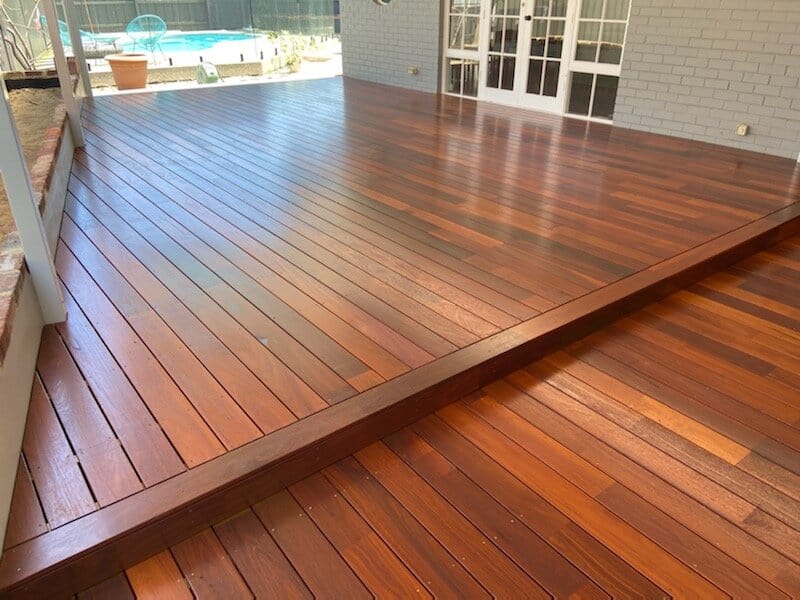An outdoor deck is something you will want to enjoy for years to come, but damp or humid climates can cause deck-damaging mould growth, so it’s important to be planned for adequate care and maintenance.
Mould can happen anywhere but is indeed more prevalent in places that are humid, especially at certain times of the year. While there are ways to remove mould or mildew from your deck, the best solution is prevention, so it’s in your best interest to have a solid preventative plan in place to stay a few steps ahead of any growth.
What causes mould?
To grow and thrive, mould needs four things:
- Moisture – from water leaks, flooding, humidity, condensation
- Oxygen
- A host – such as timber, textile, food, fluids, etc.
- Warm temperature – ideally 25-37 degrees C
Mould spores can easily travel through the air from multiple sources and land on your deck. Once there, they are fed by organic material, like your deck’s timber and residue like dust and debris that’s naturally found on your outdoor deck.
Most decks are made from hardwood or composite material; both of which are porous and can be susceptible to mould growth. However, composite decking is designed to be mould-proof and some hardwoods like Jarrah are more resistant, especially when treated and sealed regularly.
Methods to remove mould
Removing mould can be time consuming, especially if the spores have already rooted into the material. Mould can quickly spread across the deck so getting rid of mould on your deck will be easiest if you catch it early. It is best done with products specifically made to remove and kill mould spores and mildew. Time and elbow grease will benefit you in your mould removal.
While pressure washing is a popular way to clean a deck, it isn’t always the best way to remove mould. The pressure of the water can actually push the mould further into your deck, causing longer-term problems and more mould issues.
Mould removal products can be incredibly harsh, as most of them will be bleach based, however there are gentler, more natural options, like a white vinegar/water mixture, baking soda and water, or clove or tea tree essential oil diluted in water, which are strong natural anti-fungals. Before you put anything on your deck, first check with your decking specialist or do a patch test to make sure you don’t damage your deck’s surface and finish.
For particularly stubborn mould, it may be necessary to apply mould remover more than once for it to be removed completely. Once the mould is removed, in damp and warm climates, it is ideal to apply a mould inhibitor to decrease the chances of it growing back.
Mould prevention measures
The best way to combat mould is proactive care and treatment for prevention.
Keep your deck clear of any organic debris like grass clippings, soil, and fallen leaves – this will help prevent the mould from feeding and growing.
Regularly wash your deck with water, and a cleaning solution to kill mould spores. Pressure washing is appropriate (and suggested) here as it helps drive all dirt off the deck. Make sure to keep the nozzle at least 12 inches from the deck to prevent damage and to follow the instructions.
Making sure that you remove any standing water – this will decrease the chances of mould growing in a damp environment.
Sunlight is one of the best natural killers of mould, since mould cannot grow in a warm and dry environment.

Love and treat your deck
Treating your deck regularly per the manufacturer’s recommendations will make sure it stays mould and mildew free. Use a water repellent after cleaning with a non-bleach detergent to make your deck an unattractive place for mould.
Timber decks and flooring require a little more love and care than their composite counterparts. The care is seasonal and should be based on the environmental conditions your deck need protection from. For humid, hot climates you would treat it for mould, for winter months you would treat the decking for water damage. Learn how to prepare your deck for winter.
Regardless of your decking material, your deck needs to be treated regularly (usually on an annual basis) to protect it. Certain hardwoods like Jarrah decking are amongst the most mould-resistant timbers for decking but, like any wood deck, will need to be treated for the best outcome.
Mould and mildew can be damaging to both your health and your deck. While it can be removed, taking measures to prevent mould and mildew is the best approach.
Want to learn more about all things decking and deck care? Check out our decking blog now.

































